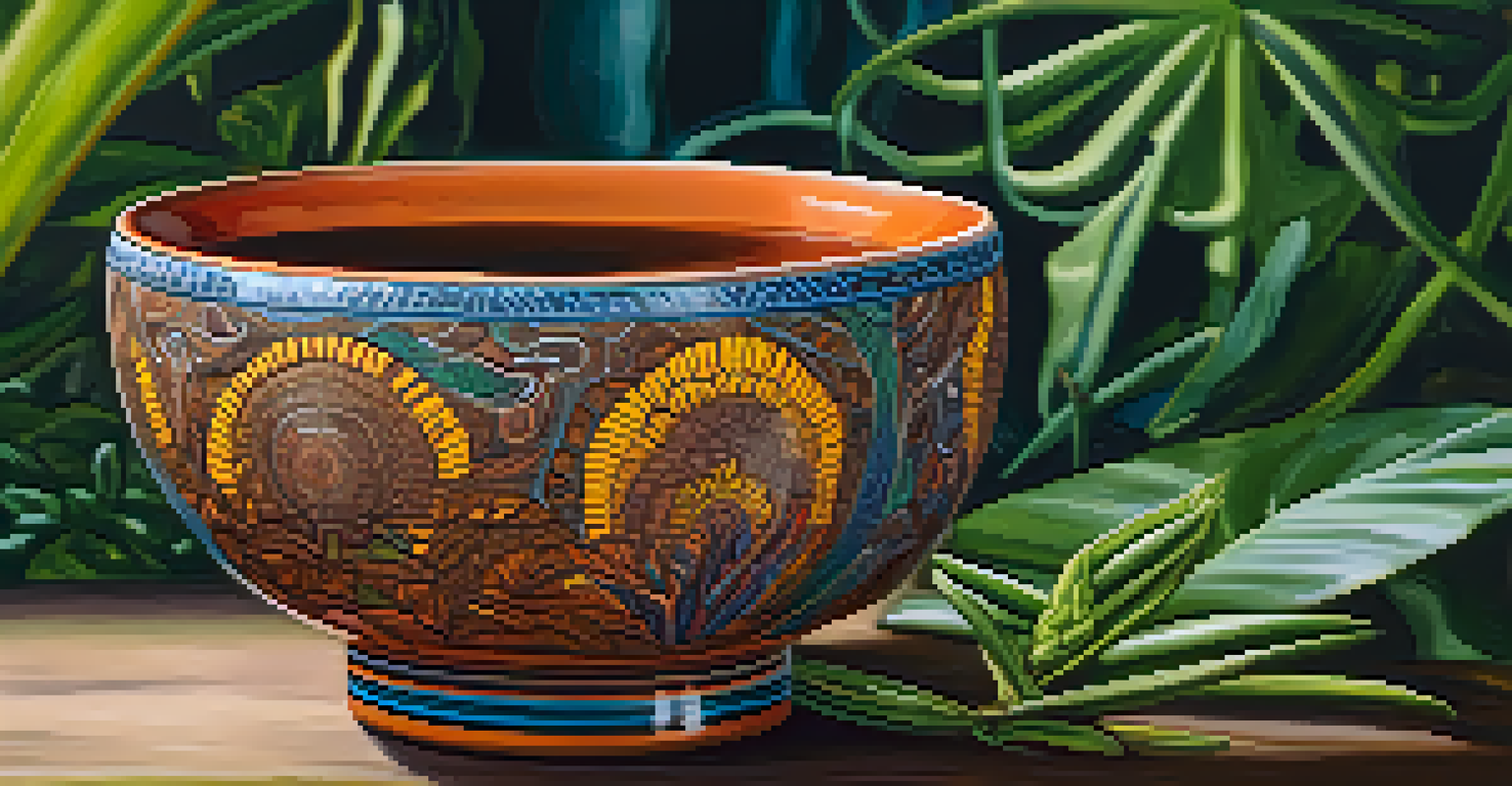Ayahuasca: The Bridge Between the Physical and Spiritual

What is Ayahuasca and Its Historical Significance?
Ayahuasca is a traditional herbal brew originating from the Amazon rainforest, primarily used by indigenous communities for spiritual healing and rituals. This potent mixture typically combines the Banisteriopsis caapi vine with the leaves of the Psychotria viridis plant, creating a powerful psychoactive experience. Historically, shamans and healers have utilized Ayahuasca in ceremonies to connect with the spiritual world, seeking guidance and insights.
The experience of Ayahuasca is not just about the brew; it is about the journey of the spirit and the lessons learned along the way.
The brew has gained popularity beyond its cultural roots, drawing interest from people around the globe who are curious about its potential for personal growth and healing. As more individuals seek out Ayahuasca experiences, it has sparked discussions about cultural appropriation and the importance of respecting indigenous practices. Understanding its historical context is essential to appreciate the depth of its significance in spiritual journeys.
In essence, Ayahuasca serves not only as a means to explore the mind but also as a bridge connecting us to ancient traditions. This rich history invites us to consider how spiritual practices can inform our modern lives, leading to deeper self-awareness and understanding.
The Role of Ayahuasca in Spiritual Awakening
For many, participating in an Ayahuasca ceremony is a transformative experience that facilitates spiritual awakening. The brew often induces intense visions and emotional releases, allowing individuals to confront personal traumas and gain new perspectives on their lives. Many report feelings of interconnectedness with the universe, which can lead to profound insights about their purpose and direction.

During these ceremonies, participants often find themselves in a safe and supportive environment, guided by experienced shamans or facilitators. This setting encourages vulnerability and openness, crucial elements for deep spiritual work. As the Ayahuasca takes effect, participants may experience a range of emotions, from elation to sorrow, ultimately leading to a cathartic release.
Ayahuasca's Cultural Roots Matter
Understanding Ayahuasca's historical significance is crucial for respecting its indigenous origins and spiritual practices.
The journey with Ayahuasca can be likened to peeling back layers of an onion—each layer revealing deeper truths about oneself. This process fosters a sense of clarity and understanding that can last long after the experience, often inspiring individuals to make positive changes in their lives.
Understanding the Science Behind Ayahuasca
While Ayahuasca is steeped in tradition, scientific research is beginning to unveil its potential benefits. The primary psychoactive compound in Ayahuasca, DMT (dimethyltryptamine), is known for its hallucinogenic properties. However, the brew's effects are also attributed to the combination of the plants used, which work together to create a unique experience that affects both the mind and body.
Ayahuasca is a bridge to the wisdom of the ancients, guiding us through the depths of our own consciousness.
Studies have shown that Ayahuasca can lead to increased serotonin levels in the brain, promoting feelings of well-being and emotional stability. Additionally, some research suggests that it may help alleviate symptoms of depression and anxiety, making it a topic of interest in the field of mental health. As more people seek alternative therapies, Ayahuasca is becoming a focal point for those exploring holistic healing options.
Understanding the science behind Ayahuasca doesn't diminish its spiritual significance; rather, it enhances our comprehension of how this ancient practice can benefit modern individuals. By merging traditional wisdom with scientific inquiry, we can better appreciate the multifaceted nature of Ayahuasca and its role in bridging physical and spiritual experiences.
Ayahuasca Ceremonies: What to Expect
Attending an Ayahuasca ceremony can be both exciting and daunting. It's essential to prepare mentally and physically, as the experience can be intense. Most ceremonies begin with participants setting intentions for their journey, which helps focus the mind and heart on what they hope to achieve during the session.
Typically held in a serene and safe environment, these ceremonies are led by a shaman or experienced facilitator who guides participants through the process. The setting is often dimly lit, creating a calming atmosphere conducive to introspection and connection. Participants may engage in group singing, drumming, or chanting, which adds to the collective energy of the experience.
The Healing Potential of Ayahuasca
Ayahuasca ceremonies can facilitate profound spiritual awakenings and personal transformations through intense emotional and visionary experiences.
As the Ayahuasca takes effect, individuals may experience a wide range of sensations and emotions. It’s not uncommon to encounter both beautiful visions and challenging moments, as the brew encourages deep reflection. Remember, each person's experience is unique, and it’s essential to remain open and adaptable throughout the journey.
The Potential Risks and Challenges of Ayahuasca
While many people report positive experiences with Ayahuasca, it's crucial to acknowledge potential risks and challenges. The brew can cause intense physical reactions, including nausea and vomiting, often referred to as 'purging.' This purging is viewed by some as a necessary part of the healing process, but it can be unsettling for first-time participants.
Additionally, individuals with certain mental health conditions or those taking specific medications should approach Ayahuasca with caution. It's vital to consult with healthcare professionals before participating in a ceremony, as interactions can lead to adverse effects. Awareness of these risks allows participants to make informed decisions about their spiritual journeys.
Despite these challenges, many find that the insights gained from Ayahuasca outweigh the discomfort. The key is to approach the experience with respect, understanding, and readiness, allowing for a more profound exploration of the self.
Integrating Ayahuasca Experiences into Daily Life
After an Ayahuasca ceremony, the process of integration becomes crucial for maximizing the experience's benefits. Participants are often left with profound insights and emotions that require time and reflection to fully understand. Journaling, meditation, or discussing experiences with trusted friends can help solidify these revelations and translate them into everyday life.
Integration involves taking the lessons learned during the ceremony and applying them to daily routines and relationships. This might mean making lifestyle changes, addressing unresolved issues, or even simply cultivating a deeper sense of gratitude. Many find that their Ayahuasca experiences inspire them to pursue personal growth actively.
Integration is Key Post-Ceremony
Effectively integrating insights gained from Ayahuasca experiences into daily life is essential for fostering personal growth and well-being.
By consciously integrating these insights, individuals can foster a lasting connection between their physical and spiritual selves. This ongoing journey encourages continuous self-discovery, ultimately enhancing quality of life and personal fulfillment.
The Future of Ayahuasca in Modern Society
As interest in Ayahuasca grows, its role in modern society continues to evolve. More people are seeking alternative therapies for mental health and spiritual growth, prompting discussions about the ethical implications of its use outside indigenous contexts. It’s essential to approach this sacred practice with respect and mindfulness, ensuring that participants honor its origins and cultural significance.
The growing popularity of Ayahuasca retreats and ceremonies also raises questions about regulation and safety standards. As the industry expands, ensuring that participants have access to qualified facilitators and safe environments becomes increasingly important. This focus on responsible practices can help maintain the integrity of Ayahuasca as a healing tool.

Ultimately, the future of Ayahuasca lies in its ability to bridge cultures and foster understanding. By sharing knowledge and experiences, we can create a collective appreciation for this powerful brew, allowing it to serve its purpose as a conduit between the physical and spiritual realms.